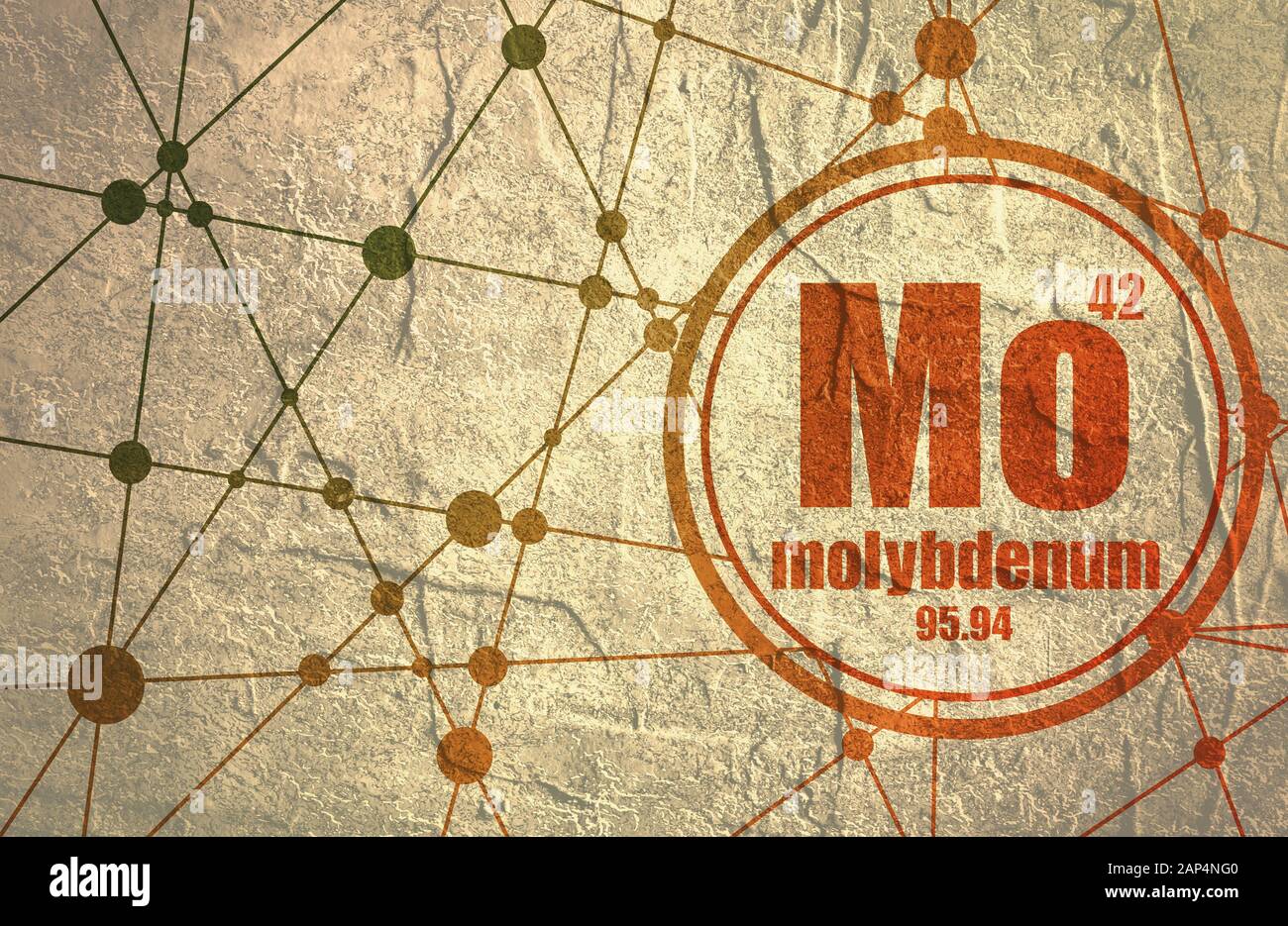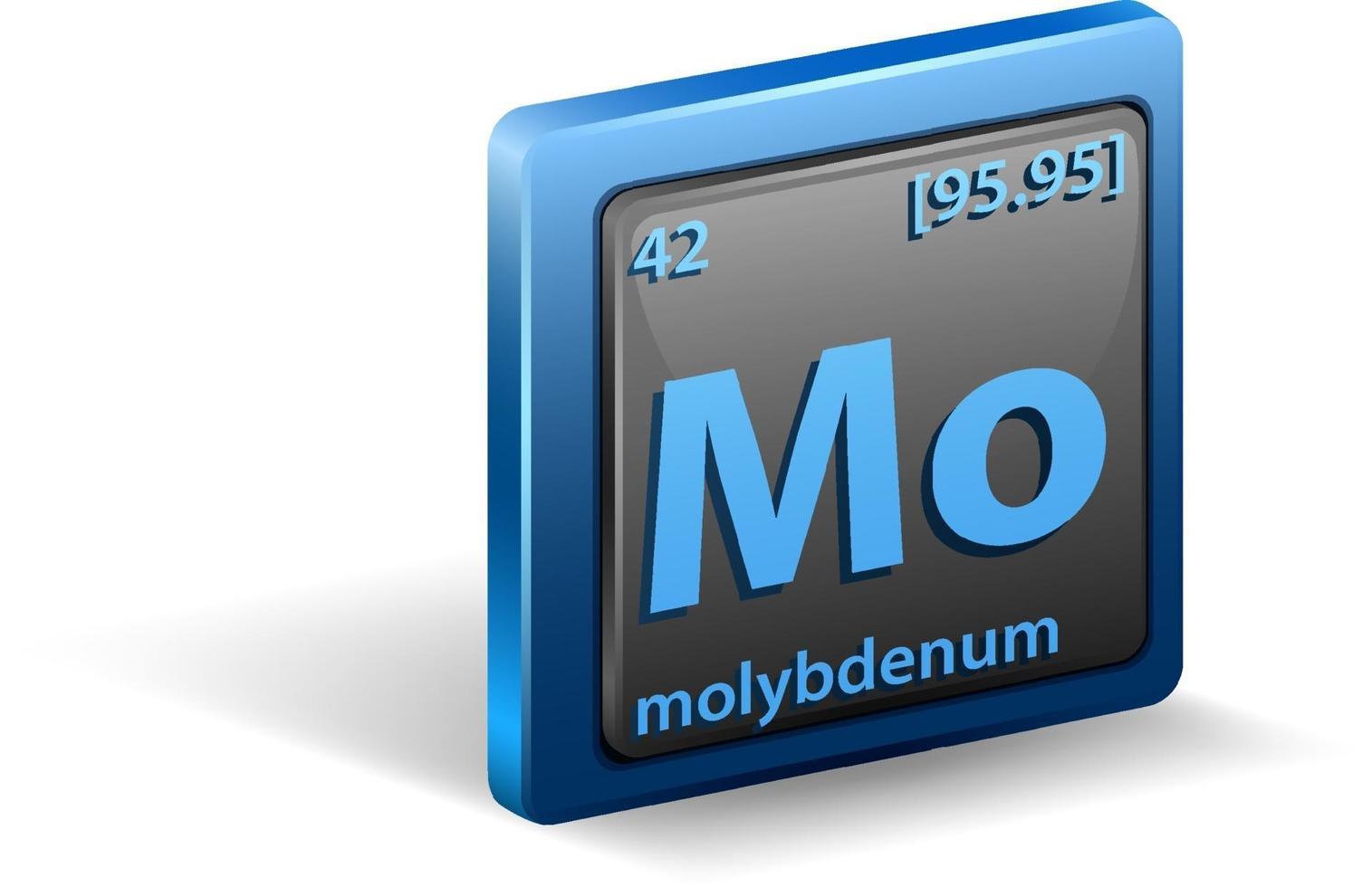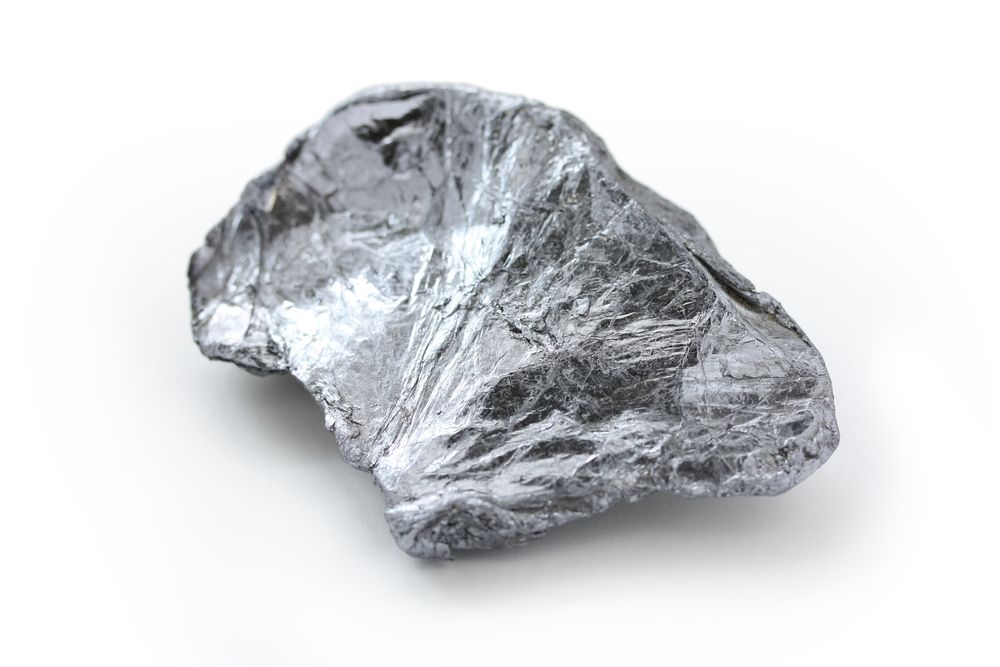Mo Molybdenum Element 42 Mass Number: 96 Atomic weight: 95.95 g/mol Atomic number (Z): 42 Electrons: 42 Protons: 42 Neutrons: 54 Period: 5 Group: 6 Block: d. Atomic Number: 42: Atomic Radius: 209 pm (Van der Waals) Atomic Symbol: Mo: Melting Point: 2623 °C: Atomic Weight: 95.96. Molybdenum does not occur natively, but.
Molybdenum was discovered in 1778 by Carl Wilhelm Scheele. It is a biologically important element but is toxic in high concentration.

History and Discovery
Molybdenum is an ancient metal and its ore, molybdenite, was initially confused and used as graphite and the common lead, galena (PbS). Evidence of use of molybdenum alloys have been found from 14th century when it was used in Japan to make swords. In 1754, Bengt Qvist, proposed for the first time that molybdenite does not contain lead. Molybdenum was discovered by Carl Wilhelm Scheele in 1778 and later in 1781 it was isolated as impure form by Peter Jacob Hjelm. The name molybdenum has been derived from Neo-Latin molybdaenum and from Greek word molybdos that means lead. The name has been given as initially molybdenum ores were primarily confused with lead ores [1].
Molybdenum

| Periodic Table Classification | Group 6 Period 5 |
|---|---|
| State at 20C | Solid |
| Color | Gray metallic |
| Electron Configuration | [Kr] 4d5 5s1 |
| Electron Number | 42 |
| Proton Number | 42 |
| Electron Shell | 2, 8, 18, 13, 1 |
| Density | 10.22 g.cm-3 at 20°C |
| Atomic number | 42 |
| Atomic Mass | 95.94 g.mol -1 |
| Electronegativity according to Pauling | 2.16 |
Occurrence
It does not occur in free or elemental form in nature mostly it is present in minerals and ores. Molybdenum is not a rare element. It is ranked as the 54th most abundant element in the earth and 42nd most abundant element in the universe. It is present in around 10 parts per billion on earth and traces of molybdenum have been found on the moon [2]. Molybdenum is widely present in many enzymes of bacterial plants’ and animal’s origin and around 50 such enzymes have been reported. The most common minerals of molybdenum include molybdenite (MoS2), powellite and wulfenite. Molybdenum is produced commercially as a by-product of tungsten and copper mining. The largest producers of molybdenum are China, Peru, USA, Mexico and Chilli.
Physical Characteristics
Molybdenum is a greyish silver transition metal. It has significantly high melting point, around 2623 degree centigrade. Molybdenum has considerable low coefficient of thermal expansion as compared to other metals. It is a dense metal and has a density of around 10.28 g/cm3. Molybdenum has high tensile strength which increases significantly with a decrease in diameter. It does not readily dissolve in water in elemental form but most minerals of molybdenum are quite soluble in water.
Chemical Characteristics
Molybdenum is not a very reactive metal. Molybdenum occurs in a wide range of oxidation states, from -2 to +6 with having prevalence of higher oxidation states in various organic and inorganic compounds. The most stable oxidation states are +4 and +6. Molybdenum reacts with chlorine in wide range of oxidation states to form molybdenum (II, III, IV, and V) chloride. It does not react with water or oxygen at room temperature and at higher temperatures, 300 degree centigrade, molybdenum undergoes weak oxidation and at temperatures above 600 degree centigrade it undergoes significant oxidation to produce molybdenum trioxide. Molybdenum trioxide and molybdenum dioxide are the most commercially significant compounds of molybdenum
Significance and Uses
- Molybdenum is used as fertilizers for certain plants for example cauliflower.
- Molybdenum is also used to make steel alloys to impart weldability and resistance to corrosion.
- Molybdenum disulphide is used as lubricant as it can withstand high temperature and pressure.
- Molybdenum disilicide is used to make ceramic that has electrical conductivity.
- Molybdenum trioxide is used to make adhesives to bind metals to enamels.
- Molybdenum anodes are used in x-ray sources.
Health Effects
Molybdenum is biologically important element and is considered essential for life of most plants and animals. In bacteria molybdenum containing enzymes play important role in biological nitrogen fixation. Molybdenum is required in trace amount in human body and is part of four crucial mammalian enzymes [3]. The primary dietary sources of molybdenum include sunflower seeds, cucumber, lentils, green beans and eggs. Prolonged and high amount ingestion of molybdenum can lead to growth retardation, diarrhoea, low birth rate and damage to lungs and kidneys.
Isotopes of Molybdenum
Molybdenum Atomic Number
There are around thirty five isotopes of molybdenum, with atomic mass ranging from 83 to 117. It only has 7 naturally occurring isotopes: molybdenum-92, molybdenum-94, molybdenum-95, molybdenum-96, molybdenum-97, molybdenum-98 and molybdenum-100.
Molybdenum-100 is the only naturally occurring unstable isotopes. It has a half-life of 1019 years and undergoes decay through emission of beta particles and transform into ruthenium-100. The most stable, abundant and naturally occurring isotope is Molybdenum-98.
REFERENCES
[1]. Lide, David R., ed. (1994). “Molybdenum”. CRC Handbook of Chemistry and Physics. 4. Chemical Rubber Publishing Company. p. 18. ISBN0-8493-0474-1.
[2]. Jambor, J.L.; et al. (2002). “New mineral names” (PDF). American Mineralogist. 87: 181.
[3]. Schwarz, Guenter; Belaidi, Abdel A. (2013). “Chapter 13. Molybdenum in Human Health and Disease”. In Astrid Sigel; Helmut Sigel; Roland K. O. Sigel. Interrelations between Essential Metal Ions and Human Diseases. Metal Ions in Life Sciences. 13. Springer. pp. 415–450. doi:10.1007/978-94-007-7500-8_13
Other Periodic Table Elements
- Lead
Lead has been known since old ages and its use has been largely limited due…
- Tennessine
Tennessine is a synthetic element that was discovered in 2010. It is highly radioactive and…
- Moscovium
Moscovium is a synthetic element that was discovered in 2003. It is a highly radioactive…

Chemical properties of molibdenum - Health effects of molybdenum - Environmental effects of molybdenum
|
MolybdenumThe metal is silvery white, very hard transition metal, but is softer and more ductile than tungsten. Scheele discovered it in 1778. It was often confused with graphite and lead ore. It has a high elastic modulus, and only tungsten and tantalum, of the more readily available metals, have higher melting points. Molybdenum has one of the highest melting points of all pure elements. Molybdenum is attacked slowly by acids. Applications Molybdenum is a valuable alloying agent, as it contributes to the hardenability and toughness of quenched and tempered steels. It also improves the strength of steel at high temperatures. Molybdenum is used in alloys, electrodes and catalysts. The Second World War German artillery piece called 'Big Bertha' contains molybdenum as an essential component of its steel. It is used in certain nickel-based alloys, such as the 'Hastelloys(R)' which are heat-resistant and corrosion-resistant to chemical solutions. Molybdenum oxidizes at elevated temperatures. The metal has found recent application as electrodes for electrically heated glass furnaces and foreheaths. The metal is also used in nuclear energy applications and for missile and aircraft parts. Molybdenum is valuable as a catalyst in the refining of petroleum. It has found applications as a filament material in electronic and electrical applications. Molybdenum is an essential trace element in plant nutrition. Some lands are barren for lack of this element in the soil. Molybdenum sulfide is useful as a lubricant, especially at high temperatures where oils would decompose. Almost all ultra-high strength steels with minimum yield points up to 300,000 psi(lb/in.2) contain molybdenum in amounts from 0.25 to 8%. Molybdenum powders are used in circuit inks for circuit boards, and in microwaves devices and heat sinks for solid-state devices. Molybdenum in the environment Molybdenum differs from the other micronutrients in soils in that it is less soluble in acid soils and more soluble in alkaline soils, the result being that its availability to plants is sensitive to pH and drainage conditions. Some plants can have up to 500 ppm of the metal when they grow on alkaline soils. Molybdenite is the chief mineral ore, with wulfenite being less important. Some molybdenite is obtained as a by-product of tungsen and copper production. The main mining areas are the USA, Chile, Canada and Russia, with world production being around 90.000 tonnes per year, and reserves amounting to 12 million tonnes of which 5 million tonnes are in the USA.Health effects of molybdenumBased on animal experiments, molybdenum and its compounds are highly toxic. Some evidence of liver dysfunction with hyperbilirubinemia has been reported in workmen chronically exposed in a Soviet Mo-Cu plant. In addition, signs of gout have been found in factory workers and among inhabitants of Mo-rich areas of Armenia. The main features were joint pains in the knees, hands, feet, articular deformities, erythema, and edema of the joint areas
|
More from 'Elements'
Atomic Number Chart

Lenntech (European Head Office)
Distributieweg 3
2645 EG Delfgauw
The Netherlands
Phone: +31 152 610 900
fax: +31 152 616 289
e-mail: info@lenntech.com
Lenntech USA LLC (Americas)
5975 Sunset Drive
South Miami, FL 33143
USA
Phone: +1 877 453 8095
e-mail: info@lenntech.com

Lenntech DMCC (Middle East)
Level 5 - OFFICE #8-One JLT Tower
Jumeirah Lake Towers
Dubai - U.A.E.
Phone: +971 4 429 5853
e-mail: info@lenntech.com
Copyright © 1998-2021 Lenntech B.V. All rights reserved
